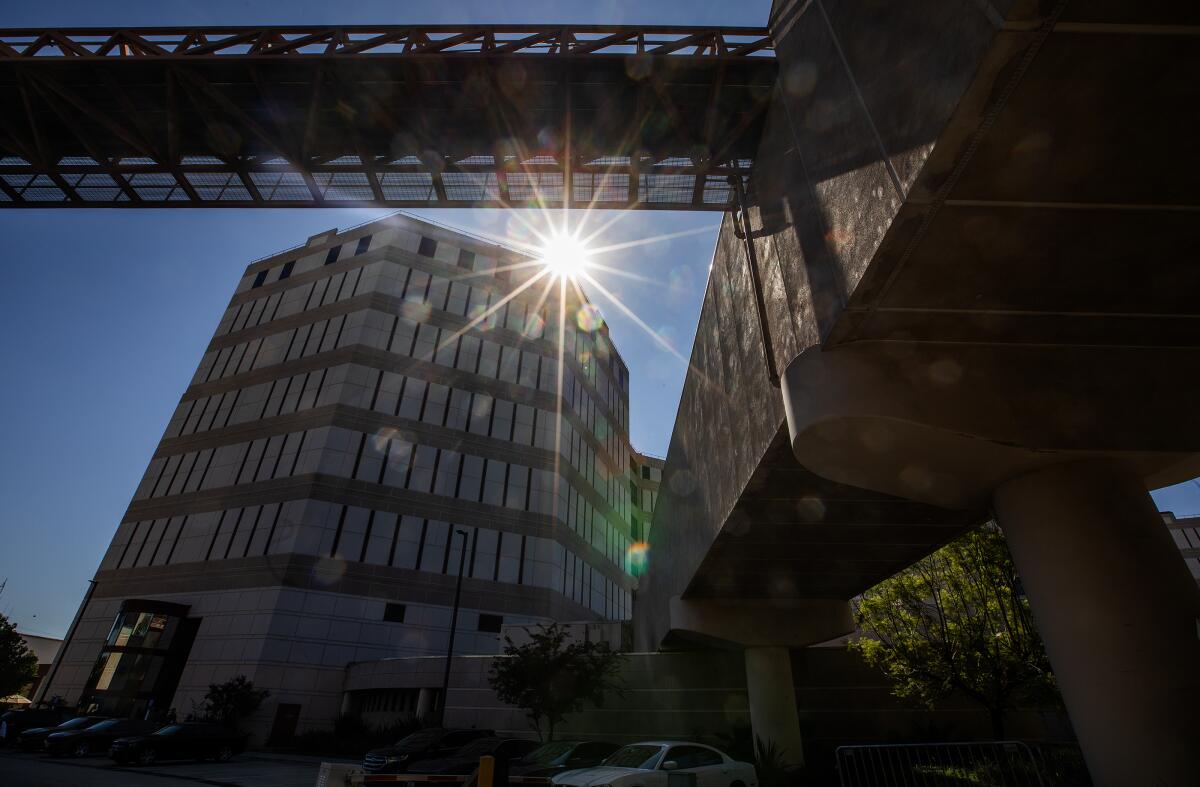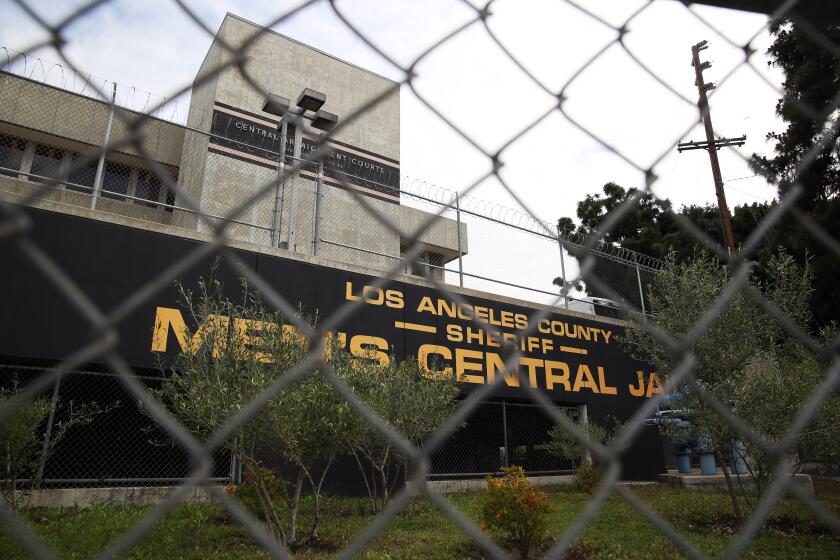State regulators find mold, broken toilets, missing fire safety records in L.A. County jails

- Share via
When state regulators showed up to inspect Men’s Central Jail in downtown Los Angeles in September they found broken toilets, moldy towels, rodent droppings and cell gates that wouldn’t lock. It appeared that guards weren’t doing their required hourly checks, and, according to state records, the facility had no proof of monthly fire inspections.
After the visit, regulators from the Board of State and Community Corrections, which oversees several hundred detention facilities across the state, marked the aging jail as “noncompliant,” with a variety of safety and sanitation violations . They directed county officials to fix the problems.
But the board’s nearly 500-page November report, which outlined findings from its fall inspections, shows the problems are not confined to Men’s Central Jail. Officials also identified issues at Twin Towers Correctional Facility and the Inmate Reception Center as well as at several jail facilities in Castaic.
In an emailed statement on Thursday, the L.A. County Sheriff’s Department, which oversees the jails, said it “welcomes the scrutiny” from the state board, which “has led to meaningful revisions to our policies and procedures and an opportunity to take positive steps to better serve our incarcerated population.”
The department also pointed out that, after the inspections, regulators returned to review progress toward fixing the problems — and found that some of compliance issues had been corrected.
“Our facilities have implemented a monthly fire and life inspection covering each living area and appropriate unit orders were updated,” the department’s statement continued. “The Department is committed to working diligently to become compliant with all the deficiencies outlined in the BSCC inspection report.”
The state board confirmed this week that the Sheriff’s Department has made some changes and updated its policies on fire and safety inspections, but added that Sheriff Robert Luna will still be asked to appear at the February board meeting to discuss compliance concerns.
To some reform advocates, the department’s failure to consistently adhere to state standards is a troubling reminder of the ongoing problems inside the county jails – which are currently the subject of three major federal lawsuits.
“This is a watershed moment for the ACLU’s jail and prison decarceration movement,” Corene Kendrick, deputy director, ACLU National Prison Project, said.
“Not surprisingly, this is disturbing confirmation of what we’ve heard from people inside,” said Michelle Parris, director of the Vera Institute of Justice’s California office. “Despite a jail population that’s 25% lower than it was a few years ago, and despite spending millions of dollars, conditions seem to be worsening, and the number of jail deaths is growing.”
This year, inspectors identified hundreds of failures to comply with state regulations during annual visits to more than 400 facilities across the state. Records show many of the noncompliance items, including numerous problems outlined in San Diego County facilities, stemmed from a failure to make required updates to department policies, not from specific sanitation or safety issues.
In Los Angeles County, the violations inspectors found at the jails in the northern part of the county had to do with the structures themselves, which are housing more inmates than they’re approved for.
In the downtown jails, the compliance issues stemmed more from operational and safety problems. At the Inmate Reception Center, the report said, jailers weren’t properly documenting their use of a controversial restraint mechanism known as the WRAP, which encases inmates in a blanket-like device from their ankles to their shoulders.
Even before the state board released its report this month, the department’s use of the WRAP had come under scrutiny in the course of a federal lawsuit over jailers’ use of force against inmates.
At the Twin Towers Correctional Facility, where mentally ill detainees are frequently housed, the BSCC found inmates weren’t let out of their cells for the seven hours a week required by state regulations. And, just like at Men’s Central Jail across the street, regulators raised concerns about fire safety planning.
The trove of jail security footage was released after The Times and Witness LA asked a federal judge to make the videos public.
From October 2022 through August 2023, state officials said, the Sheriff’s Department failed to document fire and life safety inspections, though it told regulators that maintenance staff had performed some required checks during that time.
Following the fall report, the department updated its policy and method for documenting monthly inspections, and also turned over proof of some recently completed inspections, according to state officials.
In addition to the regular inspections by the state board, California jails are required to have annual inspections done by county health officials and biennial inspections by fire officials. In recent years, both of those inspections have turned up a variety of problems.
A September 2020 health inspection at the women’s jail — the Century Regional Detention Facility in Lynwood — found dirt in food preparation areas, unlabeled bottles of chemicals, broken sinks and toilets, urine stains on floor tiles and peeling paint.
That same month, health inspectors found similar problems elsewhere, as well as an infestation of small flies in the showers of one unit at the Inmate Reception Center; broken lights and leaking ceilings at Men’s Central Jail; toilets coated in feces at Twin Towers; and rusted sinks, broken dishwashers and mold stains at the facilities in Castaic.
In early 2020, county fire inspectors found the women’s jail didn’t have required certifications for its sprinkler system or fire alarms. The following year, inspectors found three of the Castaic facilities had violated the state fire code due to broken emergency lighting, unsafe wiring, failure to maintain fire alarm systems and fire extinguishers and a series of other concerns.
And although online records show Men’s Central Jail was granted fire clearance by the Los Angeles Fire Department in May 2020 — along with a short notation saying “work in progress per COVID-19” — a Times investigation recently found that the facility does not have smoke alarms in the inmate housing areas and has been struggling with near-constant fires.
In Men’s Central Jail, they say, there is almost always something burning. But there are no smoke alarms where inmates live.
Using purloined or makeshift lighters, inmates in the 60-year-old downtown lockup routinely start blazes to heat water, cook food, light contraband cigarettes or just stay warm. In June, an oversight inspector with the county’s Sybil Brand Commission was alarmed to see large fires burning inside three cells she passed in a second-floor cell block.
“It’s like a Third World country,” the inspector, Mary Veral, told her fellow commissioners at a meeting the following month.. “I’ve been in that jail many times, and that one, it was wild.”
To Parris, the solution to years of troubling reports and investigations is clear.
“We need accountability for the horrific conditions, more urgency put to decarceration through connection to services and finally closing Men’s Central Jail,” Parris said. “Our Board of Supervisors knows that these conditions beneath human dignity stigmatize and traumatize people and make all of us less safe.”
More to Read
Sign up for Essential California
The most important California stories and recommendations in your inbox every morning.
You may occasionally receive promotional content from the Los Angeles Times.

















